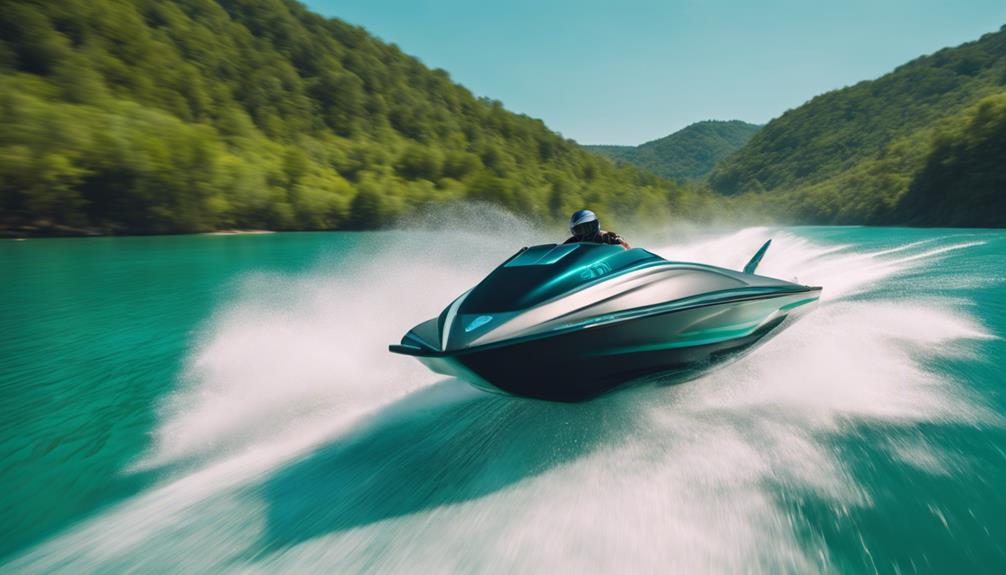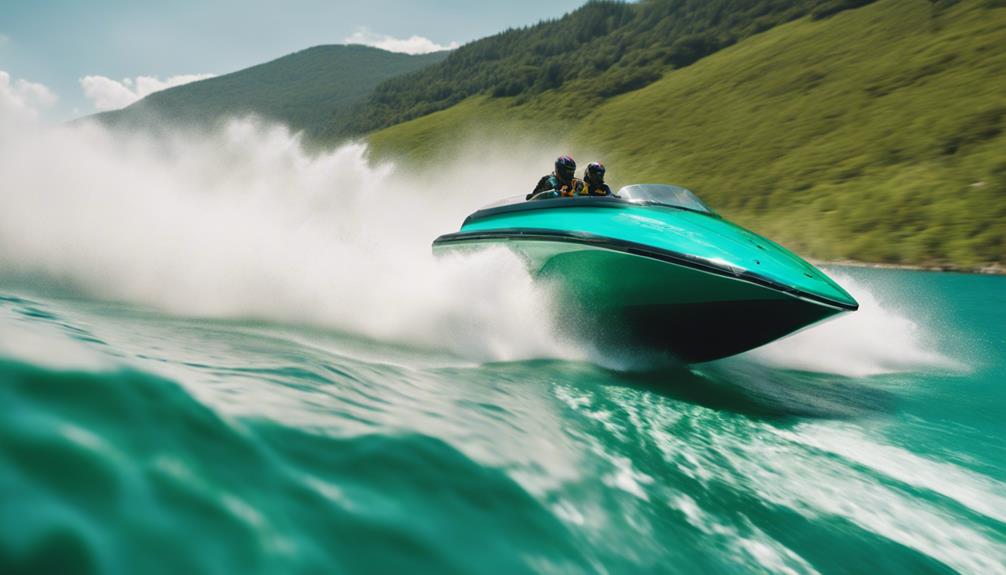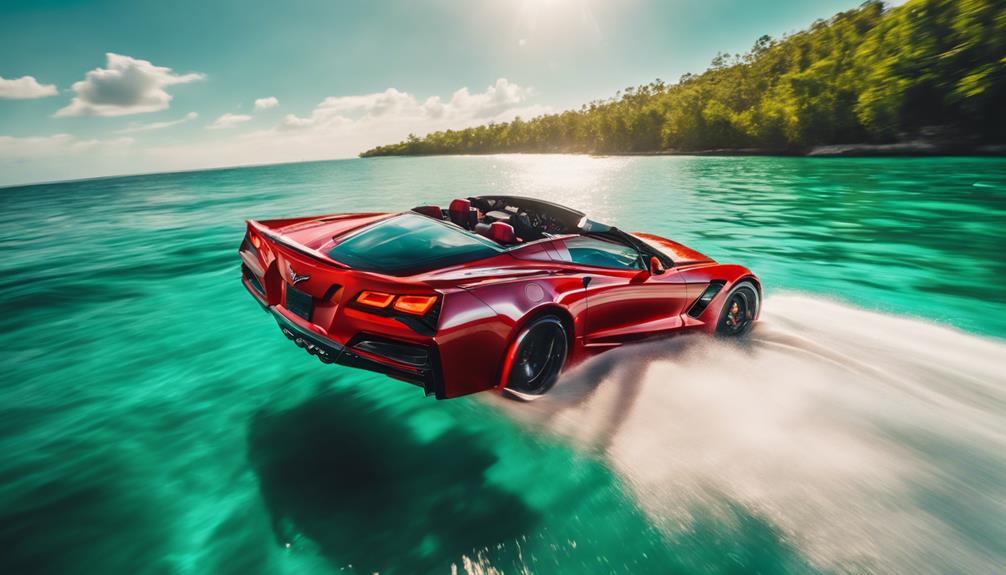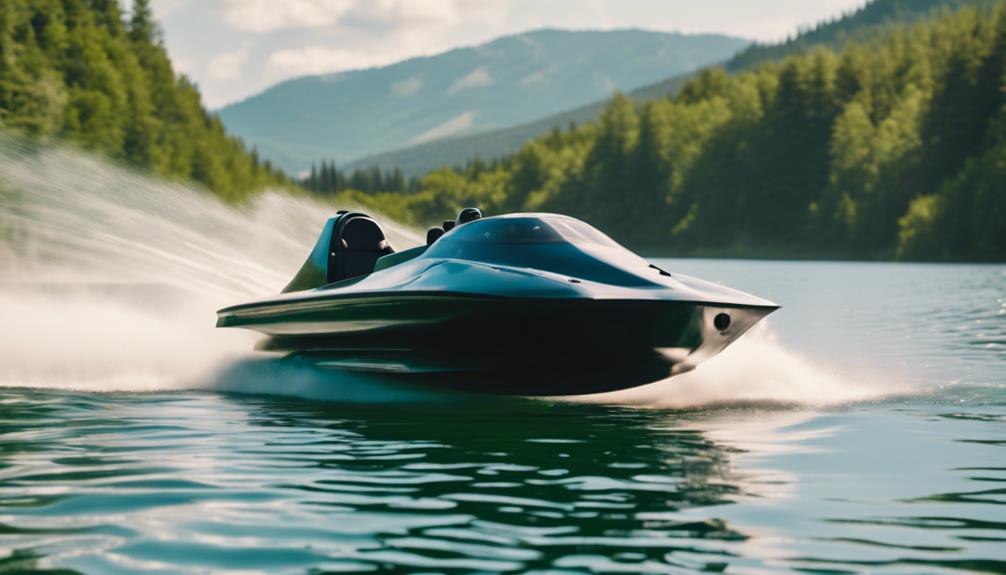No, a jet boat isn't considered a PWC. Jet boats are classified as boats under boating regulations, which means they have different safety requirements compared to PWCs. While PWCs are designed for one to three riders and allow standing or kneeling, jet boats accommodate more passengers, typically seating between two and ten. They also focus on stability and speed rather than maneuverability. Understanding these distinctions is key for choosing the right watercraft for your activities. Stick around to discover more about jet boats and how they fit into the boating world!
Key Takeaways
- Jet boats are classified as boats, while PWCs are categorized as personal watercraft, reflecting their design and operational differences.
- Jet boats are designed for seated operation and can accommodate more passengers, typically ranging from 2 to 10.
- PWCs allow riders to sit, stand, or kneel, accommodating only 1 to 3 riders, distinguishing their usage from jet boats.
- Both jet boats and PWCs have different safety regulations and requirements under U.S. Coast Guard standards.
Definition of Jet Boats
Jet boats are distinct types of watercraft designed for seated operation, setting them apart from personal watercraft (PWCs) that often allow for standing or sitting rides.
Unlike PWCs, jet boats are powered by inboard engines and feature a jet propulsion system. This design not only enhances performance but also provides a more stable ride, accommodating multiple passengers—typically ranging from two to ten—making them ideal for group activities.
When it comes to boating regulations, jet boats are classified as boats rather than PWCs. This means they must adhere to standard boating regulations, including registration and compliance with safety requirements. These regulations guarantee that you operate your jet boat safely and legally on the water.
Additionally, jet boats can achieve impressive speeds and are commonly used for recreational activities like water skiing and wakeboarding. Their capability to carry more passengers and their focus on seated operation further distinguish them from personal watercraft, solidifying their unique classification in the boating world.
Differences Between Jet Boats and PWCs
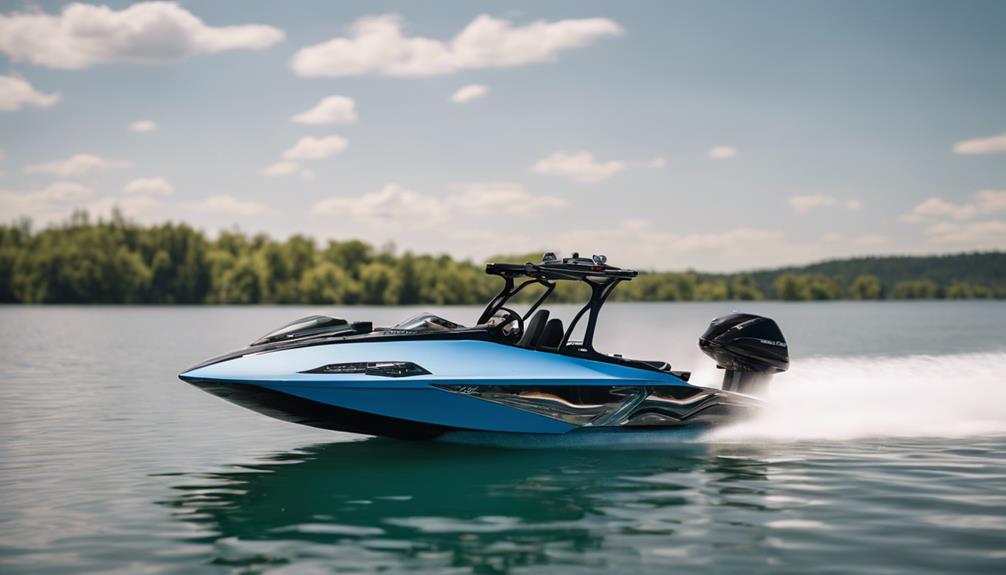
The key differences between jet boats and PWCs lie in their design, capacity, and regulatory classifications, influencing how you enjoy various water activities.
Jet boats are designed with a cockpit for seated operation, making them ideal for group outings. You can often accommodate 10 or more individuals, providing a spacious experience on the water.
In contrast, PWCs are more versatile; they allow riders to sit, stand, or kneel, accommodating only one to three riders at a time.
Regulatory classifications also set these watercraft apart. Jet boats are legally classified as boats, while PWCs fall under the category of personal watercraft. This distinction leads to different safety requirements, with PWCs typically needing stricter personal safety equipment, such as mandatory PFDs for everyone onboard.
When it comes to propulsion, both jet boats and PWCs utilize jet systems, but their purposes diverge. PWCs focus on quick maneuverability for recreational thrills, while jet boats are built for stability and high-speed cruising.
Understanding these differences helps you choose the right watercraft for your adventures on the water.
Legal Classifications Explained

Understanding the legal classifications of jet boats and PWCs is important for guaranteeing compliance with safety regulations and enjoying your time on the water responsibly.
Jet boats are classified as vessels under U.S. law, distinct from personal watercraft (PWCs). This classification stems from their design, which includes a cockpit for seated operation, differing from the stand-up or kneeling posture typical of PWCs.
The U.S. Coast Guard categorizes jet boats under standard boating regulations, requiring compliance with broader boating safety mandates. Unlike PWCs, classified as Class A inboard motor vessels, jet boats must adhere to registration requirements similar to traditional boats. You'll need to display a registration number and follow local laws to guarantee you're operating legally.
Additionally, operation rules for jet boats may differ from those applicable to PWCs. Restrictions on night operation and wake jumping, for instance, can vary by jurisdiction.
Staying informed about these legal classifications helps you navigate the waters safely and responsibly, aligning with guidelines set by the Personal Watercraft Industry Association and guaranteeing a fun, compliant boating experience.
Safety Regulations for Jet Boats
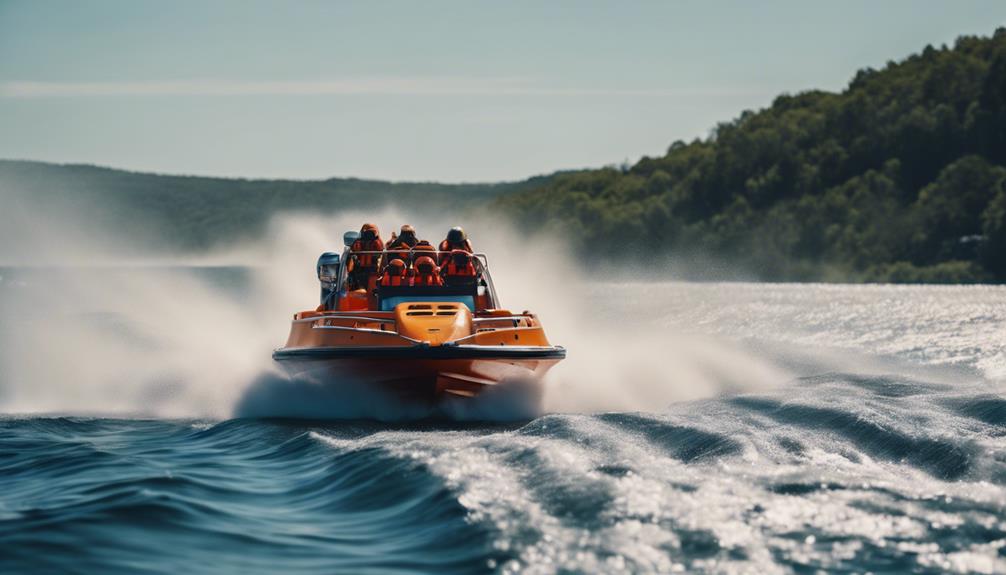
Assuring compliance with safety regulations is essential for operating jet boats safely on the water. As an operator, you need to be aware of the specific requirements set forth by the Coast Guard and local laws.
Here's a quick overview of key safety regulations for jet boats:
| Safety Requirement | Description |
|---|---|
| Personal Flotation Devices (PFDs) | All passengers must wear Coast Guard-approved PFDs. |
| Fire Extinguisher | A fire extinguisher is mandatory on board. |
| Proper Lookout | Always maintain a proper lookout to avoid collisions. |
| Navigational Rules | Follow all navigational rules to assure safety. |
| Night Operation | Prohibited unless equipped with appropriate lighting. |
Environmental Considerations
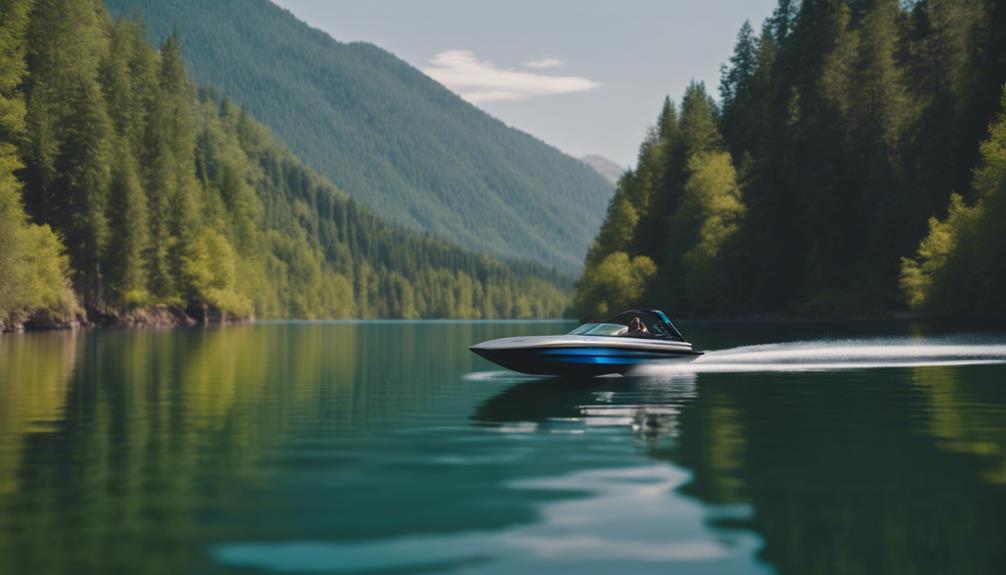
When you're out on a jet boat, it's important to contemplate its impact on the environment.
Jet boats can affect water quality, contribute to noise pollution, and disrupt local wildlife.
Water Quality Impact
Jet boats, while fun for recreation, can greatly impact water quality and local ecosystems if not operated responsibly. Though they're classified as boats rather than personal watercraft (PWC), their environmental impact is significant.
Both jet boats and PWCs can contribute to water pollution through fuel spills and oil leaks, which pose serious risks to aquatic ecosystems. You should be aware that operating jet boats in shallow waters can increase turbidity, harming fish spawning grounds and disrupting feeding patterns of birds and other wildlife.
To minimize the water quality impact, it's crucial to follow designated operating zones. These areas are established to protect sensitive marine habitats and help promote sustainable recreational practices.
By adhering to these guidelines, you can enjoy your time on the water while also safeguarding the environment. Remember, responsible operation of jet boats not only enhances your experience but also preserves the natural beauty and health of our waterways.
Always be conscious of your actions and their consequences, ensuring that your fun doesn't come at the expense of local ecosystems.
Noise Pollution Effects
While jet boats offer exhilarating experiences on the water, their loud engines can considerably contribute to noise pollution, impacting both aquatic ecosystems and nearby communities. The sound levels produced by these vessels can exceed 90 decibels, which can disturb the delicate balance of life in our waters.
Here are some key effects of noise pollution from jet boats:
- Interference with Marine Mammals: High sound levels disrupt communication and navigation among species like dolphins and whales, leading to stress and altered behaviors.
- Altered Fish Behavior: Studies show that noise pollution affects fish feeding and spawning patterns, which can have long-term impacts on local fish populations.
- Community Disturbance: The loud engines can overshadow the peace of lakes and rivers, affecting the enjoyment of nature for nearby residents and recreational users.
Fortunately, some manufacturers are responding to these concerns by developing quieter engine technologies and sound-reducing designs.
Additionally, many regions have established noise regulations to protect aquatic life and enhance the experience for everyone who enjoys these natural spaces.
Wildlife Disruption Concerns
Operating a jet boat near sensitive wildlife habitats can greatly disrupt local ecosystems and endanger vulnerable species. When you're operating a PWC, it's important to recognize that the high speed and noise of your vessel can lead to wildlife disruption. Marine mammals and birds can suffer stress or injury due to these disturbances, particularly in critical breeding seasons.
| Impact Type | Description | Wildlife Affected |
|---|---|---|
| Noise Pollution | High-speed operations create significant noise | Marine Mammals, Birds |
| Habitat Disruption | Disturbance of nesting areas near shorelines | Shorebirds, Fish |
| Turbidity | Increased sediment disrupts feeding habits | Aquatic Wildlife |
Popular Uses and Trends
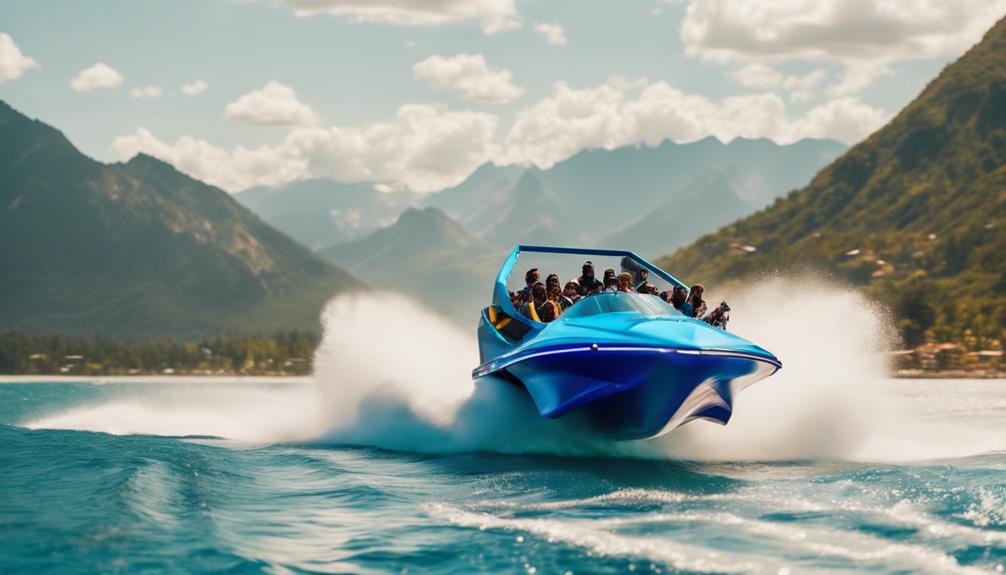
When you think about jet boats, consider how they're used for fun activities like water skiing and fishing.
The growth of rental services has made these boats more accessible, attracting tourists looking for unique experiences.
Plus, competitive racing events are gaining popularity, showcasing the thrill and versatility of jet boats on the water.
Recreational Activities Overview
Jet boats are increasingly popular for recreational activities, offering thrilling experiences for families and adventure seekers alike. As a PWC operator, you'll find that these boats are perfect for a variety of water sports and fun activities on the water.
Here are three popular uses for jet boats:
- Wakeboarding: Experience the adrenaline rush as you glide over the water while being towed behind a jet boat. It's a favorite among thrill-seekers!
- Waterskiing: Whether you're a beginner or a pro, jet boats provide the speed and agility needed for an exciting waterskiing adventure.
- Organized Events and Races: Join enthusiast communities that host races and events, adding a competitive edge to your recreational purposes.
Seasonal usage patterns for jet boats typically align with those of PWCs, peaking during warmer months. This trend highlights the growing appeal of jet boats for water sports enthusiasts.
With their versatility and engaging nature, jet boats have established themselves as a top choice for anyone looking to enjoy the great outdoors on the water.
Rental Services Growth
As interest in water-based activities continues to rise, rental services for personal watercraft (PWCs) have seen significant growth, making it easier for everyone to enjoy thrilling experiences on the water. Many coastal and lakeside destinations now offer a variety of PWCs for tourists and recreational users, attracting both inexperienced and seasoned riders alike.
The PWC rental market has expanded by about 10% annually, driven by a surge in adventure tourism. During warmer months, especially holidays and summer vacations, rental services peak as families and groups seek fun outdoor experiences.
With many rental companies providing guided tours and organized events, you can enjoy a more engaging experience while promoting safety among novice operators. Modern PWCs come equipped with advanced safety features, making them appealing for those who might be hesitant to ride.
Plus, many rental services require participants to complete a safety course before hitting the water, ensuring that each PWC is operated by a person who's knowledgeable and prepared. This trend not only enhances safety but also contributes to a more enjoyable and memorable experience on the water.
Competitive Racing Events
Expanding on the excitement found in water-based activities, competitive racing events highlight the thrilling capabilities of jet boats, attracting enthusiasts and spectators alike. These events showcase the power and agility of jet boats, all while adhering to safety regulations set by the Coast Guard.
Here are three key aspects of competitive racing events:
- Diverse Racing Classes: Jet boat racing features various classes, allowing for different designs and engine configurations to compete. This variety adds depth to the competition and caters to a wider range of racers.
- Global Participation: Events are held in countries like the United States, Canada, and Australia, fostering a sense of community among participants and spectators. You'll find both amateur and professional racers, making it an inclusive sport.
- Technological Advancements: The rise of technology in jet drive design hasn't only enhanced performance but also improved safety features, making the operation of personal watercraft (PWC) more accessible for everyone.
Frequently Asked Questions
Is a Jet Boat a Pwc?
No, a jet boat isn't a PWC. It's classified as a boat due to its design and operational features, allowing for more passengers and stability, while PWCs are typically smaller and operated differently.
Is a Jet Ski Considered a Pwc?
Imagine gliding over shimmering waters; you ask, "Is a Jet Ski considered a PWC?" Yes, it is! Jet Skis, a popular brand of personal watercraft, are thrilling rides on the waves, perfect for adventure seekers.
What Is a Jet Ski Classified As?
A Jet Ski's classified as a personal watercraft (PWC). It's a recreational vessel under 16 feet, powered by an inboard motor and water jet pump, typically accommodating one or two riders for thrilling water adventures.
What Class of Boat Is a Jet Ski?
While many boats glide elegantly through water, a Jet Ski stands out as a Class A inboard motor vessel. You'll find it classified as a Personal Watercraft (PWC) by the U.S. Coast Guard.
What is the Classification of a Jet Boat and How Does it Differ from a PWC?
When it comes to the classification of a jet boat and how it differs from a PWC, it’s important to understand some jet boat porpoising troubleshooting tips. Jet boats have a hull that is designed to skim across the water, while PWCs ride on top of the water with a lower center of gravity.
Conclusion
In the end, while jet boats and PWCs share a thrilling spirit, they're distinct vessels, each with its own charm and purpose.
Picture yourself slicing through the water on a jet boat, the spray glistening in the sun, or zipping across the waves on a PWC, feeling the rush of freedom.
Understanding these differences enhances your adventures on the water, ensuring you choose the right ride for your next escapade, whether it's a leisurely cruise or an adrenaline-packed thrill.

